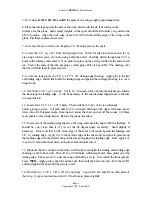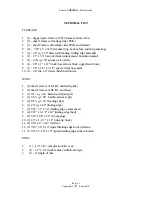
Lanier - SHRIKE 40 - Instructions
Page 4
Copyright 1998 - Lanier R/C
from the hole. Now glue in the remaining two servo mounting rails.
Note: Gluing in the
servo rails at this time will prevent the sides from bowing
out
when pulling them
together at the front.
11. Locate the firewall
F2
and layout the holes for the engine mount. Measure up 1 1/2” from
the bottom edge and draw a line perpendicular to the side. Find the center and draw a line thru
this point perpendicular to the top edge. Center the engine mount on these lines, mark the hole
locations, and drill a 1/8" hole in each for a
4-40
blind nut. CA the nuts in place.
12. Using epoxy, glue the firewall into the slots provided in the
FS1
sides. Use clamps to hold
the sides against the firewall while the epoxy is curing.
13. Locate the upper and lower front block wood (3/8” x 3” x 12”). Note the templates on the
plans. Cut them out and lightly contact glue to the block. Now, carefully cut and sand them to
the template. They will require some sanding to fit perfect however, if you are careful you
should encounter no trouble. Do not remove the cutout for the engine until the block is glued in
place. Locate them as shown on the plans. The upper block will rest against the top edge of
F2
14. Cut four pieces of 1/2" tri-stock from the 36" piece. Glue them in the nose as shown on the
plans. Two on top and two on the bottom. These are required to provide material when you
round the nose to former
Fl.
15. Cut two more pieces 6-3/4" long. Trim to size and glue these in between
F2
and
F3
flush
with the bottom edge of the fuselage. It will be necessary to add some razor saw kerfs on each
one to help them make the bend. Careful not to cut them in two.
16. Locate a 3/32" x 3 x 36" sheet and cover the entire bottom with the balsa running cross
grain. If you manage the waste carefully, one sheet will do it. So try, or you'll buy.
17. Using the remainder of the 3/32" sheet you used to make the hatch, sheet the top of the
fuselage from the front edge of
F4
aft to the trailing edge of the stab. Also from the forward
edge of the hatch to the end of the nose. The grain should run length ways in both cases. Cut
out the access hole for the engine. A Dremel Motor with a drum sander will do the job.
18. Block sand the fuselage sides to trim the top and bottom sheeting flush with them.
19. Install the engine in the mount as far as it will slide to the back leaving just a slight
clearance (less than 1/16”). Locate and drill the engine mounting holes. Also drill the holes for
the fuel lines and throttle pushrod. Now install the engine on the mount. Bolt in the engine and
mount it to the firewall. Check the distance between the front edge of the prop washer and the
end of the fuselage. Remove enough from the nose so there will be a 1/16" clearance between
the back of the spinner plate and
Fl
with the engine mounted. Keep it square. Now centrally































